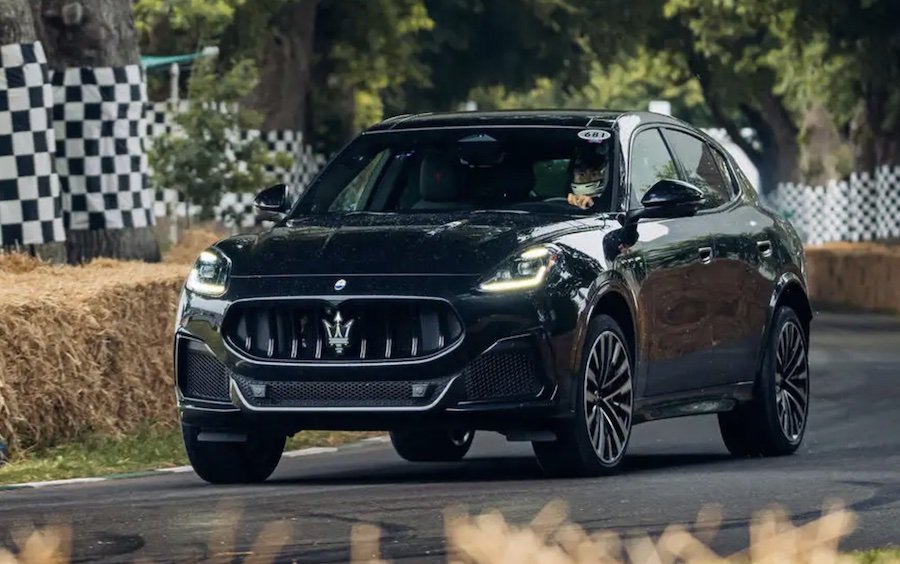New 2022 Maserati Grecale line-up topped by £95,590 V6 Trofeo

Maserati has opened order books for its flagship Grecale SUV, with prices starting from £58,500 and the first deliveries set to begin from early next year.
Primed to be the firm's most strategically important and potentially best-selling model in decades, the Grecale will launch with a choice of three specifications and power levels.
Entry-level Grecale GT models pack 296bhp and all-wheel drive, with power sourced from a 2.0-litre hybrid powertrain.
Standard equipment includes LED headlights, a reversing camera, active cruise control and parking sensors. All cars are also fitted with a 12.3in touchscreen and an 8.8in digital driver's display.
Mid-range Modena cars feature a slight power boost, to 325bhp, and command a £64,500 price.
Range-topping Trofeo models swap out the hybrid powertrain for a more powerful 3.0-litre V6, which produces 525bhp for a 0-62mph sprint of 3.8sec and a top speed of 177mph.
The new Grecale SUV provides the Italian firm with a long-awaited rival to the Porsche Macan and will play a fundamental role in its rapid transition to electrification.
Revealed shortly after Maserati parent company Stellantis announced that the brand – along with Alfa Romeo, DS and Lancia – will launch only electric cars from 2025, the Grecale has been engineered to accommodate pure-combustion, hybrid and fully electric drivetrains (see below), which will lend it a similar flexibility of purpose to its German rival, itself due a pure-EV in 2023.
It sits below the Levante in the Maserati line-up and will be joined in dealerships by the long-awaited second-generation Granturismo sports car - which will also be offered with an electric drivetrain, as well as the all-new versions of the Maserati Quattroporte and Maserati Levante, due in the coming years, each with a full spread of drivetrain options.
Powertrains
The Grecale will be available from launch with three petrol engine options: a variant of the 3.0-litre ‘Nettuno’ V6 first used by the MC20 supercar for the top-spec Trofeo, and two four-cylinder mild-hybrid set-ups for the entry-level Grecale GT and mid-rung Modena.
The V6 uses the same pre-chamber combustion technology as the full-fat MC20 engine, which aims to boost both performance and efficiency, but has been modified in line with its more mainstream billing. It has a wet rather than dry oil sump, for example, and can deactivate the right cylinder bank at a cruise for reduced consumption. This function necessitated a ‘complete redesign’ in order to accommodate collapsible tappets that allow the valvetrain on that side of the engine to be deactivated independently.
Outputs of 523bhp and 457lb ft deliver a sprint time to just 3.8sec - quicker than the BMW X3 M Competition.
The mild-hybrid cars, meanwhile, start with 296bhp and 332lb ft from a twin-turbocharged 2.0-litre unit mated to a belt-integrated starter-generator (BiSG) and a 48V battery in the boot to give improved economy and an electrical power boost under hard acceleration. Maserati claims a 0-62mph time of 5.6sec, 30.7-32.5mpg on the WLTP combined cycle and – crucially – an engine note “that retains the usual characteristics of any other Trident-brand car”. In the Modena, it is tuned to give 325bhp and 332lb ft for a 0-62mph time of 5.3sec.
All engines send their reserves through an eight-speed ZF automatic gearbox to both axles, with a self-locking limited-slip differential fitted to the rear of the Modena and Trofeo as standard, and optional on the GT.
Chassis
The Grecale measures 4846mm long by 1670mm tall and 2163mm wide, with a wheelbase of 2901mm, which makes it a similar size to the similarly conceived Alfa Romeo Stelvio SUV - no coincidence, given it fundamentally shares that car’s acclaimed Giorgio underpinnings.
Optional air suspension gives six levels of adjustment over a 65mm height range – sitting lowest in Park mode and at full height in Off-road – and a new Vehicle Dynamic Control Module (VDCM) serves as “a top-ranking orchestral conductor” for all dynamic elements of the chassis. Maserati says this system’s predictive intervention into suspension movements differs according to the drive mode selected (Comfort, GT, Sport, Race or Off-road) and gives “levels of performance and integration that could not have been achieved in the older architecture”.
Related News


